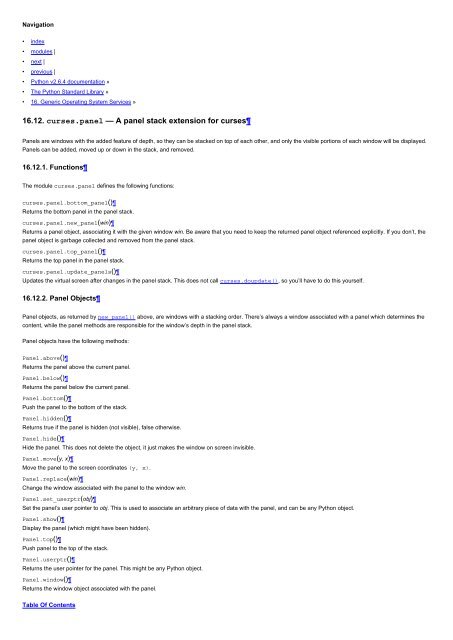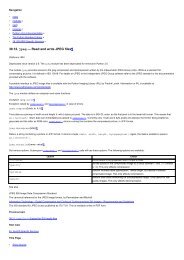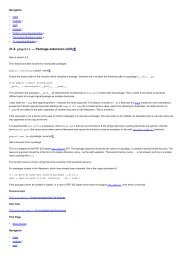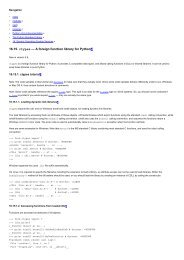A panel stack extension for curses â Python v2.6.4 documentation
A panel stack extension for curses â Python v2.6.4 documentation
A panel stack extension for curses â Python v2.6.4 documentation
You also want an ePaper? Increase the reach of your titles
YUMPU automatically turns print PDFs into web optimized ePapers that Google loves.
Navigation• index• modules |• next |• previous |• <strong>Python</strong> <strong>v2.6.4</strong> <strong>documentation</strong> »• The <strong>Python</strong> Standard Library »• 16. Generic Operating System Services »16.12. <strong>curses</strong>.<strong>panel</strong> — A <strong>panel</strong> <strong>stack</strong> <strong>extension</strong> <strong>for</strong> <strong>curses</strong>Panels are windows with the added feature of depth, so they can be <strong>stack</strong>ed on top of each other, and only the visible portions of each window will be displayed.Panels can be added, moved up or down in the <strong>stack</strong>, and removed.16.12.1. FunctionsThe module <strong>curses</strong>.<strong>panel</strong> defines the following functions:<strong>curses</strong>.<strong>panel</strong>.bottom_<strong>panel</strong>()Returns the bottom <strong>panel</strong> in the <strong>panel</strong> <strong>stack</strong>.<strong>curses</strong>.<strong>panel</strong>.new_<strong>panel</strong>(win)Returns a <strong>panel</strong> object, associating it with the given window win. Be aware that you need to keep the returned <strong>panel</strong> object referenced explicitly. If you don’t, the<strong>panel</strong> object is garbage collected and removed from the <strong>panel</strong> <strong>stack</strong>.<strong>curses</strong>.<strong>panel</strong>.top_<strong>panel</strong>()Returns the top <strong>panel</strong> in the <strong>panel</strong> <strong>stack</strong>.<strong>curses</strong>.<strong>panel</strong>.update_<strong>panel</strong>s()Updates the virtual screen after changes in the <strong>panel</strong> <strong>stack</strong>. This does not call <strong>curses</strong>.doupdate(), so you’ll have to do this yourself.16.12.2. Panel ObjectsPanel objects, as returned by new_<strong>panel</strong>() above, are windows with a <strong>stack</strong>ing order. There’s always a window associated with a <strong>panel</strong> which determines thecontent, while the <strong>panel</strong> methods are responsible <strong>for</strong> the window’s depth in the <strong>panel</strong> <strong>stack</strong>.Panel objects have the following methods:Panel.above()Returns the <strong>panel</strong> above the current <strong>panel</strong>.Panel.below()Returns the <strong>panel</strong> below the current <strong>panel</strong>.Panel.bottom()Push the <strong>panel</strong> to the bottom of the <strong>stack</strong>.Panel.hidden()Returns true if the <strong>panel</strong> is hidden (not visible), false otherwise.Panel.hide()Hide the <strong>panel</strong>. This does not delete the object, it just makes the window on screen invisible.Panel.move(y, x)Move the <strong>panel</strong> to the screen coordinates (y, x).Panel.replace(win)Change the window associated with the <strong>panel</strong> to the window win.Panel.set_userptr(obj)Set the <strong>panel</strong>’s user pointer to obj. This is used to associate an arbitrary piece of data with the <strong>panel</strong>, and can be any <strong>Python</strong> object.Panel.show()Display the <strong>panel</strong> (which might have been hidden).Panel.top()Push <strong>panel</strong> to the top of the <strong>stack</strong>.Panel.userptr()Returns the user pointer <strong>for</strong> the <strong>panel</strong>. This might be any <strong>Python</strong> object.Panel.window()Returns the window object associated with the <strong>panel</strong>.Table Of Contents
16.12. <strong>curses</strong>.<strong>panel</strong> — A <strong>panel</strong> <strong>stack</strong> <strong>extension</strong> <strong>for</strong> <strong>curses</strong>• 16.12.1. Functions• 16.12.2. Panel ObjectsPrevious topic16.11. <strong>curses</strong>.ascii — Utilities <strong>for</strong> ASCII charactersNext topic16.13. plat<strong>for</strong>m — Access to underlying plat<strong>for</strong>m’s identifying dataThis Page• Show SourceNavigation• index• modules |• next |• previous |• <strong>Python</strong> <strong>v2.6.4</strong> <strong>documentation</strong> »• The <strong>Python</strong> Standard Library »• 16. Generic Operating System Services »© Copyright 1990-2010, <strong>Python</strong> Software Foundation.The <strong>Python</strong> Software Foundation is a non-profit corporation. Please donate.Last updated on Feb 26, 2010. Created using Sphinx 0.6.3.
















